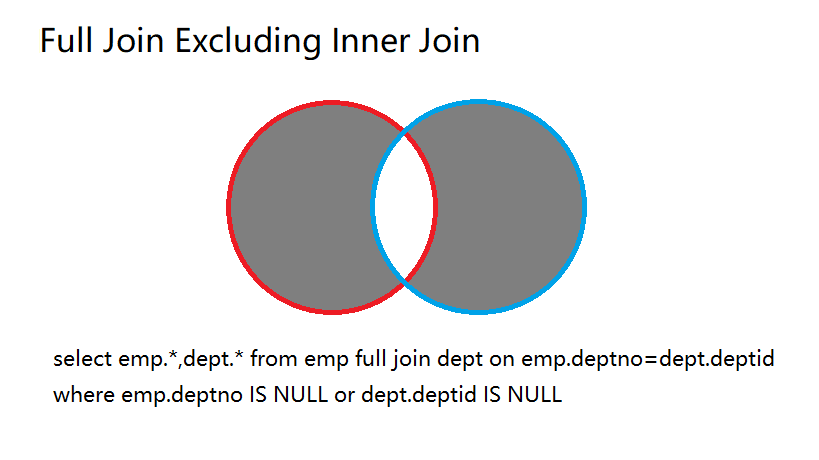在上一篇 https://www.cnblogs.com/xiandedanteng/p/12327809.html 里,我们发现有三种SQL语句可以达到目的,而且也把查询结果打印了出来,通过肉眼鉴别发现结果是一致的。
但是,这是结果集有限的情况,当结果集成千上万时,如何知道不会出现一条例外呢?
用程序进行鉴别是一种方法,其实有一句SQL可以帮助我们解决问题,那就是Full join excluding inner join:

上图来自:https://www.cnblogs.com/xiandedanteng/p/12267949.html
将这种连接用到实例中就是:
select t1.*,t2.* from test01 t1 full join test02 t2 on (t1.id=t2.id) where (t1.id IS NULL or t2.id IS NULL)
把上篇提出的左连方案,group内连方案,not exists方案放入test01,test02里,如果查不出结果,那就证明test01,test02代表的结果集是一致的。
左联和group内连方案比较的sql语句是:
select t1.*,t2.* from (SELECT a.* from tb_scoreflow a left JOIN tb_scoreflow b on a.stuid = b.stuid and a.sbjid = b.sbjid and b.cdate > a.cdate where b.cdate IS NULL order by a.stuid,a.sbjid) t1 full join ( select a.* from tb_scoreflow a , (select stuid,sbjid,max(cdate) as cdate from tb_scoreflow group by stuid,sbjid) b where a.stuid=b.stuid and a.sbjid=b.sbjid and a.cdate=b.cdate order by a.stuid,a.sbjid) t2 on (t1.id=t2.id) where (t1.id IS NULL or t2.id IS NULL)
运行结果是:
SQL> select t1.*,t2.* 2 from 3 (SELECT 4 a.* 5 from 6 tb_scoreflow a 7 left JOIN tb_scoreflow b on 8 a.stuid = b.stuid 9 and a.sbjid = b.sbjid 10 and b.cdate > a.cdate 11 where b.cdate IS NULL 12 order by a.stuid,a.sbjid) t1 full join 13 ( select 14 a.* 15 from 16 tb_scoreflow a , 17 (select stuid,sbjid,max(cdate) as cdate from tb_scoreflow 18 group by stuid,sbjid) b 19 where 20 a.stuid=b.stuid and 21 a.sbjid=b.sbjid and 22 a.cdate=b.cdate 23 order by a.stuid,a.sbjid) t2 24 on (t1.id=t2.id) 25 where (t1.id IS NULL or t2.id IS NULL); 未选定行
这说明左连和group内连方案的结果集是一致的。
group内连和not exists方案进行比较的sql是:
select t1.*,t2.* from ( select a.* from tb_scoreflow a , (select stuid,sbjid,max(cdate) as cdate from tb_scoreflow group by stuid,sbjid) b where a.stuid=b.stuid and a.sbjid=b.sbjid and a.cdate=b.cdate order by a.stuid,a.sbjid) t1 full join (select a.* from tb_scoreflow a where not exists( select null from tb_scoreflow b where b.stuid=a.stuid and b.sbjid=a.sbjid and b.cdate>a.cdate) order by a.stuid,a.sbjid) t2 on (t1.id=t2.id) where (t1.id IS NULL or t2.id IS NULL)
执行结果是:
SQL> select t1.*,t2.* 2 from 3 ( select 4 a.* 5 from 6 tb_scoreflow a , 7 (select stuid,sbjid,max(cdate) as cdate from tb_scoreflow 8 group by stuid,sbjid) b 9 where 10 a.stuid=b.stuid and 11 a.sbjid=b.sbjid and 12 a.cdate=b.cdate 13 order by a.stuid,a.sbjid) t1 full join 14 (select 15 a.* 16 from tb_scoreflow a 17 where not exists( select null 18 from tb_scoreflow b 19 where b.stuid=a.stuid and 20 b.sbjid=a.sbjid and 21 b.cdate>a.cdate) 22 order by a.stuid,a.sbjid) t2 23 on (t1.id=t2.id) 24 where (t1.id IS NULL or t2.id IS NULL); 未选定行
这也说明group内联方案和not exists方案的结果集是一致的。
至此,已经可以证明 左连接==group内连==not exists方案,无论结果集大小,我们都无需担心出现一条例外了。
--2020年2月22日--